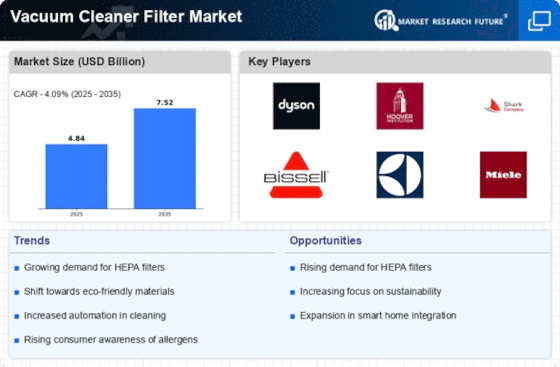Expansion of E-commerce Platforms
The proliferation of e-commerce platforms has significantly influenced the Vacuum Cleaner Filter Market. Consumers now have easier access to a wide range of vacuum cleaner filters, allowing for informed purchasing decisions. Online sales channels have seen a remarkable increase, with estimates suggesting that e-commerce could account for over 30% of total sales in the vacuum cleaner accessories segment by 2026. This shift is not only convenient for consumers but also enables manufacturers to reach a broader audience without the constraints of traditional retail. Consequently, the competitive landscape is evolving, as brands invest in digital marketing strategies to enhance visibility and attract online shoppers. The growth of e-commerce is likely to continue shaping the dynamics of the Vacuum Cleaner Filter Market, fostering a more competitive environment.
Rising Popularity of Smart Home Devices
The integration of smart technology into household appliances is reshaping the Vacuum Cleaner Filter Market. As smart home devices gain traction, consumers are increasingly seeking vacuum cleaners equipped with advanced features such as app connectivity and automated cleaning schedules. This trend is driving the demand for compatible filters that enhance the performance of these smart devices. Market analysis indicates that the segment of smart vacuum cleaners is projected to grow at a rate of 10% annually, further boosting the need for specialized filters. Manufacturers are responding by developing filters that not only fit smart vacuums but also optimize their efficiency. This convergence of technology and home cleaning solutions is likely to redefine consumer expectations and drive innovation within the Vacuum Cleaner Filter Market.
Regulatory Standards and Compliance Requirements
The Vacuum Cleaner Filter Market is increasingly influenced by regulatory standards aimed at improving product safety and environmental impact. Governments are implementing stricter regulations regarding air quality and emissions, which directly affect the design and manufacturing of vacuum cleaner filters. Compliance with these standards is becoming essential for market players, as non-compliance could lead to penalties and loss of market access. Recent regulations have emphasized the need for filters that effectively capture fine particulate matter and reduce harmful emissions. This regulatory landscape is likely to drive innovation, as manufacturers invest in research and development to create filters that not only meet but exceed compliance requirements. Consequently, the focus on regulatory standards is expected to shape the future of the Vacuum Cleaner Filter Market, fostering a culture of continuous improvement.
Focus on Sustainability and Eco-Friendly Practices
The growing emphasis on sustainability is influencing the Vacuum Cleaner Filter Market. Consumers are increasingly inclined towards eco-friendly products, prompting manufacturers to explore sustainable materials for filter production. This shift is evident in the rising popularity of biodegradable and recyclable filters, which cater to environmentally conscious consumers. Market Research Future suggests that the eco-friendly segment of vacuum cleaner filters is expected to witness a growth rate of around 8% in the coming years. Companies are also adopting sustainable practices in their manufacturing processes, which not only reduces environmental impact but also appeals to a broader customer base. This focus on sustainability is likely to drive competition and innovation within the Vacuum Cleaner Filter Market, as brands strive to align with consumer values.
Increasing Demand for Indoor Air Quality Solutions
The rising awareness regarding indoor air quality has propelled the Vacuum Cleaner Filter Market. Consumers are increasingly concerned about allergens, dust, and pollutants in their living spaces. This trend is reflected in the growing sales of HEPA filters, which are known for their efficiency in trapping microscopic particles. According to recent data, the demand for high-efficiency filters is expected to grow at a compound annual growth rate of approximately 7% over the next five years. As a result, manufacturers are focusing on developing advanced filtration technologies to meet consumer expectations. This shift towards prioritizing air quality is likely to drive innovation within the Vacuum Cleaner Filter Market, as companies strive to offer products that not only clean but also enhance the overall health of indoor environments.






















Leave a Comment